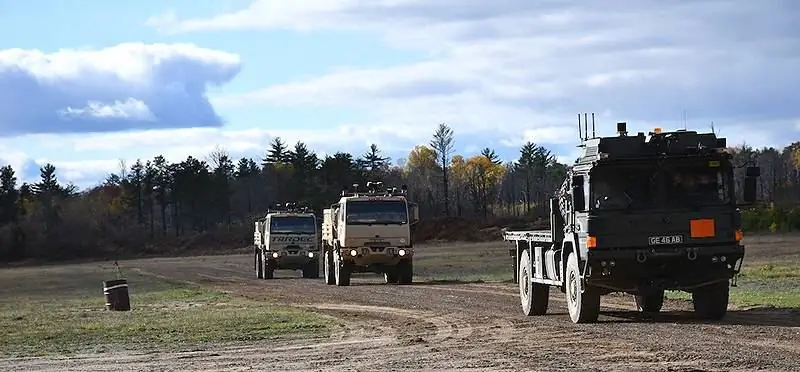- Author Matthew Elmers [email protected].
- Public 2023-12-16 21:49.
- Last modified 2025-01-24 09:17.

A US-British team tested autonomous supply technologies and concepts.
As part of the demonstration tests CAAR (Coalition Assured Autonomous Resupply), the British Defense Science and Technology Laboratory (Dstl), the American Army Armored Research Center (TARDEC), the Arms Research Center (ARDEC) tested the application remotely controlled vehicles (in the form of modified crew platforms) and unmanned aerial vehicles in logistics tasks. These demo runs took place at Camp Grayling, Michigan.
The test program included validation of the operation of a typical joint support transport convoy, as well as an autonomous coordinated last mile support scenario (on the ground and in the air) that has been developed over the past three years.
According to the Dstl laboratory, the goal of an autonomous last mile supply system is to reduce the need for existing platforms and infrastructure, reduce the risk and burden on personnel, improve the efficiency of supply operations at a given pace and schedule, and ensure a guaranteed supply of personnel on the front line to improving maneuverability in a complex combat space.
The column operated in a master-slave configuration and moved at a speed of up to 40 km / h; she was accompanied by two HMMWV armored vehicles with crews equipped with Robotic Toolkit Software control stations. The leading platform was the HX-60 British Army truck manufactured by Rheinmetall MAN Military Vehicles GmbH (RMMV), followed by two American Army LMTV (Light Medium Tactical Vehicle) trucks manufactured by Oshkosh. All trucks were equipped with Lockheed Martin's Autonomous Mobility Applique System (AMAS). AMAS is an optional multi-sensor kit that is designed to integrate with tactical wheeled vehicles and can be installed on existing vehicles.
In September 2017, TARDEC demonstrated AMAS technology by driving a mixed convoy of army trucks and civilian vehicles along Interstate 69, which was also in master-slave mode.
The technology used in AMAS integrates sensors and control systems and is based on GPS, LIDAR laser locator, vehicle radars and commercially available vehicle sensors. The system includes a navigation unit, which receives various signals, including GPS, and then, based on an arbitration algorithm that evaluates various incoming positioning data, provides position information.
The AMAS kit includes a communication antenna, which, as a rule, is installed on the roof of the vehicle along with the LIDAR and GPS antenna. The power steering system, steering wheel position sensor and steering force sensors are installed inside the machine. Also installed inside are transmission and engine controllers, an electronically controlled braking system and an electronic stability control system. Wheel position encoders are installed on the selected wheels and a stereo camera on the top of the windshield. Several short-range radars and vehicle radars are installed in the front and rear of the vehicle; also installed side radars to exclude blind spots. An accelerometer / gyrotachometer of the stability control system is installed in the center of the car.
The ground-based component of the autonomous last mile concept was the Polaris MRZR4x4 vehicle, which was remotely controlled by military personnel from the British Army Research and Test Center. The car drove along a given supply route and was controlled by a device in the form of a gaming tablet. The optional crew car weighs 867 kg, has a speed of 96 km / h and has a payload of 680 kg.
Since this is still a relatively new concept, there were backup drivers in the vehicles during the movement of the convoy. However, their services were not in demand, the cars passed the routes independently based on the data received in real time or followed the GPS coordinates. I must say that the ground components during the CAAR demonstration worked in a common radio network and were controlled from a tablet device.
Jeff Ratowski, CAAR Project Manager at the TARDEC Center, said that a test plan for September-October 2018 and September-October 2019 is currently being negotiated. "The goal is to improve the technology, increase the speed of machines and the level of integration of air and ground components."
One of the goals of the 2018 test is to operate without backup drivers. “This is truly the next step, the highest priority in the short term. We hope to start testing this technology in April 2018,”said Ratowski.
“The six vehicles of the transport convoy will include two HMMWV escort armored vehicles, two HX60 trucks and two LMTV trucks. Autonomous capabilities without standby drivers will be demonstrated. The lead HMMV vehicle will plot the route with intermediate points, while the other five vehicles will travel along this route without a driver in any of them.”
As the CAAR program evolves, the integration of air and ground components will be increasingly tested to demonstrate real-world procurement capabilities.
The demonstration was also attended by SkyFalcon drones from Gilo Industries and Hoverbike from Malloy Aeronautics.
Hoverbike is an electric quadcopter the size of a small car, capable of lifting 130kg of cargo. It can fly at a speed of 97 km / h, the maximum flight altitude is 3000 meters. The drone is made of carbon fiber reinforced with Kevlar with foam filling. The electric motors of the device can be supplemented with an on-board generator to increase the operating time. The system is controlled by means of a tablet. Hoverbike is designed for those customers who need to carry out supply operations at low altitudes in areas with difficult terrain.






